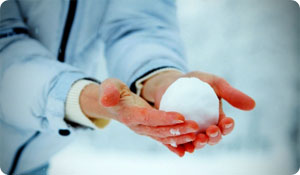
Numerous studies have compared weather and pain in patients with chronic diseases, such as arthritis and fibromyalgia. The results are not always consistent, but one thing is clear: weather sensitivity exists along a continuum and is highly individual. Furthermore, the weather can affect pain levels before, during or after the change in weather.
Cold Weather
Colder temperatures often trigger arthritis pain. In one study, 74 percent of patients reported weather sensitivity and 72 percent cited low temperatures as one of the factors most associated with increased pain.
However, don't pack your bags and head for warmer climes just yet. Climate does not affect the course of arthritis, even if it affects your level of pain.
People who are sensitive to cold will often stop exercising when the temperature drops. However, this may cause more harm than good. Exercise helps to loosen stiff joints. It also helps prevent winter weight gain, which puts extra stress on joints and worsens pain.
Take extra steps to protect your joints and minimize weather-induced pain. Dress in layers, drink tea and other warm drinks and cover up with an electric blanket. Warm up your car before driving.
Air Pressure
Change in air pressure (also called barometric pressure) also affects the body. Air pressure is the weight of the air. It decreases when altitude increases. If you watch a weather forecast, you know barometric pressure is one the primary drivers of weather patterns. Both rising and falling pressure can cause increased pain in some people.
People who suffer from rheumatoid arthritis often report increased pain when the humidity is high. In the study cited above, 66 percent of participants associated humidity with pain. Warmer temperatures can increase humidity, which can be a double whammy for sensitive people.
Skeptics blame the psychological effect of weather on reported pain more than the weather itself. They believe, for example, that cold, rainy days affect mood, which lowers pain thresholds. However, arthritis patients swear there's a very real connection. If you're unsure, keep a daily diary. Record your pain levels and all weather conditions, even atmospheric and solar variables. After a while, you'll notice if weather is triggering your arthritis pain.
Sources:
http://www.niams.nih.gov/News_and_Events/NIAMS_Update/2009/JanuaryNews.asp
http://www3.interscience.wiley.com/journal/122578779/abstract?CRETRY=1&SRETRY=0
http://www.weather.com/activities/health/achesandpains/achesandpains101/barometers.html
http://www3.interscience.wiley.com/journal/120093064/abstract





